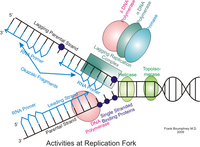
Photo from wikipedia
DNA replication initiates at DNA replication origins after unwinding of double-strand DNA(dsDNA) by replicative helicase to generate single-stranded DNA (ssDNA) templates for the continuous synthesis of leading-strand and the discontinuous… Click to show full abstract
DNA replication initiates at DNA replication origins after unwinding of double-strand DNA(dsDNA) by replicative helicase to generate single-stranded DNA (ssDNA) templates for the continuous synthesis of leading-strand and the discontinuous synthesis of lagging-strand. Therefore, methods capable of detecting strand-specific information will likely yield insight into the association of proteins at leading and lagging strand of DNA replication forks and the regulation of leading and lagging strand synthesis during DNA replication. The enrichment and Sequencing of Protein-Associated Nascent DNA (eSPAN), which measure the relative amounts of proteins at nascent leading and lagging strands of DNA replication forks, is a step-wise procedure involving the chromatin immunoprecipitation (ChIP) of a protein of interest followed by the enrichment of protein-associated nascent DNA through BrdU immunoprecipitation. The isolated ssDNA is then subjected to strand-specific sequencing. This method can detect whether a protein is enriched at leading or lagging strand of DNA replication forks. In addition to eSPAN, two other strand-specific methods, (ChIP-ssSeq), which detects potential protein-ssDNA binding and BrdU-IP-ssSeq, which can measure synthesis of both leading and lagging strand, were developed along the way. These methods can provide strand-specific and complementary information about the association of the target protein with DNA replication forks as well as synthesis of leading and lagging strands genome wide. Below, we describe the detailed eSPAN, ChIP-ssSeq, and BrdU-IP-ssSeq protocols.
Journal Title: Methods in molecular biology
Year Published: 2018
Link to full text (if available)
Share on Social Media: Sign Up to like & get
recommendations!